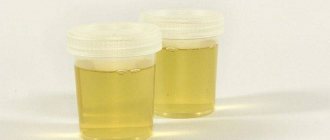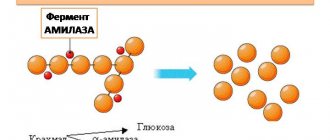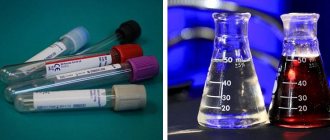The color of your baby's urine can say a lot. For example, you can determine whether he is healthy or whether he urgently needs to see a doctor. Many parents are alarmed by the change in color, especially if the child’s urine suddenly turns red.
This may indicate bleeding in the body or other pathologies that are not at all related to the hematopoietic system. Let’s take a closer look at what can affect the change in urine color to reddish, and how the cause of this condition can be eliminated.
What are the causes of the pathology?
For the most part, changes in the color of the fluid secreted in a baby occur due to physiological reasons. In addition to these, there are also pathological ones, which indicate the development of a specific inflammatory process in the body. Physiological causes are the body’s natural reactions to a certain stimulus. For example it could be:
- Eating foods that cause urine to turn red (blueberries, blackberries, black currants, beets, and those rich in artificial colors).
- Treatment with drugs that, during metabolism, act as a source of formation of reddish compounds (Metronidazole, Ibuprofen, Rifampicin, etc.).
Physiological causes of changes in the color of urine are considered to be dehydration, as well as the development of uric acid infarction. As for pathological causes, they are based on hematuria, which is typical for diseases such as hemorrhagic diathesis, thrombocytopathy, and inflammatory diseases of the urinary tract.
Dehydration
Before determining the connection between red urine and a body condition such as dehydration, it is worth considering its main components. When the child is in full health, the urine is light yellow, which can be explained by the metabolite present in it - urobilin. Urine also consists of:
- protein compounds;
- uric and hippuric acids, amino acids;
- glucose;
- sulfates and phosphates.
Due to the constant volume of the constituent components of urine, a decrease in water content in the body causes an increase in their concentration, which contributes to the darkening or redness of the excreted urine. This can occur if a child stays with a fever for a long time, as well as with insufficient water intake, vomiting or diarrhea.
Uric acid infarction
Of course, the diagnosis sounds terrifying, but uric acid infarction is not considered a pathology or dangerous disease. During the child's intrauterine stay, uric acids (their salts) accumulate in a large volume in his body, and after his birth, an increase in their volume is indicated by a change in the color of the urine to reddish or slightly cloudy. There is an increase in the concentration of urobilin in the baby’s body in the event of a physiological change in body weight.
A diagnosis of uric acid infarction can be made based on the following signs:
- the child is no more than 14 days old from birth;
- the excreted urine has a red tint;
- on the diapers you can notice the presence of red dots (crystals of uric acid salts);
- The baby’s general well-being is not affected.
Hemorrhagic diathesis
A sign of such a pathological condition is a tendency to internal bleeding, including that which comes from any organ of the urethra. There are no other diseases, the symptom of which may be internal bleeding. In most cases, diathesis of this form is considered a congenital condition.
If there is a tendency to internal bleeding, the development of an existing pathology of the urinary tract may be aggravated. However, in most cases in children, hemorrhagic diathesis is an independent disease. Other associated symptoms include:
- inflammation of the gums, as well as their bleeding;
- bleeding from the gums during teething;
- rashes on the body that look similar to subcutaneous hemorrhage;
- hemorrhage in the retina of the eyes, their redness;
- the presence of blood streaks in the stool;
- the presence of blood streaks in the vomit.
Thrombocytopathy
A change in the color of urine in a baby can occur with the development of a pathology such as thrombocytopathy. Many clinical manifestations of this painful condition are similar to hemorrhagic diathesis, but the sources of occurrence are still distinctive.
Thrombocytopathy occurs due to a genetic disorder that is inherited from the father or mother, namely, due to the inability of platelets to perform a hematopoietic function.
In addition, thrombocytopathy in a child can develop due to a woman’s illness during pregnancy with the following pathologies:
- having a viral origin;
- having an infectious origin;
- acidosis;
- sepsis.
The development of thrombocytopathy is characterized by the following symptoms: hematuria, navel bleeding, cerebral hemorrhages. Due to the increased fragility of the vascular system in infants, bleeding can occur with any physical stress, and this is: crying, pushing during bowel movements, etc.
Inflammatory processes in the urinary tract
A change in the color of urine in childhood often occurs during the development of pathologies of the urinary tract of inflammatory etiology. Such diseases are more often diagnosed in girls, because their urinary system is significantly different from that of boys: the urethra is short and located closer to the anal outlet.
The inflammatory process in the kidneys or bladder in most cases has an infectious-allergic etiology and occurs against the background of ongoing infectious diseases of the ENT organs (tonsillitis, pharyngitis, etc.). No less rarely, redness of urine is diagnosed with the development of glomerulonephritis, a kidney disease.
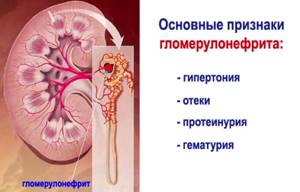
The first symptoms of glomerulonephritis occur several weeks after the infection. The main clinical manifestations include:
- constant feeling of thirst;
- decrease in the volume of urine excreted and its redness;
- swelling of the lower extremities and face;
- nausea and vomiting syndrome.
Why does blood appear in urine?
One of the common causes of hematuria in both women and men is urolithiasis during an exacerbation. The stone, passing through the ureters, injures the mucous membrane, causing its damage. At the same time, severe pain is felt. The wounds bleed, and the blood is washed off along with the urine, which is painted in the corresponding color, and the bloody discharge has a bright scarlet color.
In old age, the cause of blood in the urine may be age-related narrowing of the urinary canal. The most dangerous diagnosis for such a symptom is considered to be cancer of the prostate, bladder or kidneys. It is worth considering here that malignant tumors of these organs respond well to treatment. The main thing is to consult a doctor in time, i.e. at the first symptoms that appear.
Other possible causes of hematuria:
- taking anticoagulants (heparin or aspirin);
- wound or severe bruise of the kidney;
- bladder polyps or tumors;
- genitourinary infections.
If blood appears at the end of urination, then the cause should be sought in the bladder, if outside the process of urine excretion - in the urethra (urethra, most often due to damage to its walls). If additional joint pain is observed, the cause may be systemic lupus erythematosus.
Diagnostics
Red urine in a child may be a sign of natural processes occurring in the body. If this state of urine is observed for 3-4 days, you should sound the alarm and visit a specialist. First of all, the doctor prescribes a general urine test, the results of which confirm or refute the development of inflammation in the body.
If necessary, additional diagnostic measures are carried out, which include:
- Ultrasound examination of kidneys such as the kidneys and bladder (ultrasound);
- a general blood test, with the help of which the quantitative indicators of the components are determined;
- radiography of the kidneys.
In addition, a urine test according to Nechiporenko may be required, which is carried out to examine the urinary tract if a routine analysis does not reveal the presence of infection in the body. Another effective method for identifying the cause of red urine is the Kakovsky-Addis analysis.
In any case, you should not self-medicate and look for the cause yourself. Only a specialist can determine why a child’s urine turns red.
Causes of pink urine in newborns
The primary cause of this symptom is nutrition. Eating foods with coloring results in children's urine turning pinkish.

When a baby is breastfed, pink urine may occur if the mother's diet contains the following foods:
- beet;
- black currant;
- blueberry;
- cherry;
- blackberry;
- rhubarb;
- red or burgundy food coloring.
The above food products contain a powerful coloring pigment that can enter the baby’s body along with breast milk.
This is not a deviation, and, accordingly, does not indicate the development of pathological processes.
Urine may also turn pink as a result of using medications. After consuming them, the color of the urine returns to normal.

The following medications can turn urine pink:
- Ibuprofen;
- Amidopyrine;
- Rifampicin;
- Sodium salicylate.
That is, most urine can change color after using non-steroidal anti-inflammatory, painkillers or hormonal drugs. At the same time, this symptom is temporary, but it is still necessary to see a local pediatrician.
The coloring pigment does not affect any other parameters of urine! After eliminating these foods from the diet, the urine will again become yellowish.
How to treat
If the urine turns red due to dehydration, rehydration therapy is necessary. In this case, replenish the loss of fluid in the body with appropriate medications and sufficient drinking. In the latter case, both ordinary purified water and rice water, unsweetened compote, and saline solution are suitable.
Of the ready-made medications, it is worth highlighting Regidron and others. In severe cases, intravenous infusions of drugs are required.
If a change in the color of urine is observed due to uric acid infarction, treatment is not carried out. This phenomenon disappears on its own after a certain time (usually after 4-5 days).
Hemorrhagic diathesis can be cured with special drugs that have an enhancing effect on blood clotting ability. These include medications based on vitamins C, K, rutin, and iron. In severe cases, the child is placed in a hospital setting and resuscitation measures are carried out to help stop the bleeding.
Therapy for thrombocytopathy consists of taking hemostatic drugs for life, which will help avoid its development. These include calcium gluconate, sodium ethamsylate, Adroxon, etc.
The general principles of treatment for urinary tract diseases include correction of nutrition and drinking regime. It is worth limiting the consumption of salt and foods rich in proteins. The daily volume of fluid consumed is reduced if inflammatory kidney pathology develops and, conversely, increased if lower urinary tract disease is diagnosed.
Among the drugs used in the treatment of urinary tract infections, antibacterial drugs are used, which are prescribed only by a doctor.
Classification of hematuria
The classification of hematuria is carried out taking into account the factors that led to its development and the amount of blood in the urine.
| Types of hematuria | Characteristics |
| Classification by factors of occurrence | |
| Postrenal | The symptom appeared as a result of kidney pathologies or injuries. |
| Extrarenal | The symptom appeared as a result of other pathological conditions. |
| Classification by the amount of blood in the urine | |
| Macroscopic | The amount of blood is enough for the urine to be colored red. In addition to blood, it may contain other impurities and pus. |
| Microscopic | The amount of blood is minimal, so it has virtually no effect on the color of urine. Abnormal changes can only be detected by special tests. |
Prevention
To prevent diseases that may be accompanied by symptoms such as red urine, you need to follow some simple recommendations:
- Follow a proper diet with limited intake of salt and protein-containing foods. It is also necessary to adhere to the drinking regime.
- Avoid hypothermia, as this is the most common cause of inflammatory processes in the urinary tract.
- Regular preventive urine and blood tests, as well as an ultrasound examination of the kidneys.
As soon as you have the slightest suspicion that the color of your child’s urine is unnatural, you should consult a specialist. Based on the results of the studies, the doctor will prescribe the most effective treatment.
Symptoms accompanying change in urine color
Colored urine in an infant is a cause for concern. The problem may arise during the introduction of complementary foods. If after discontinuation of the new product the situation has not changed, or symptoms of the disease are present, urgent consultation is required.
Attention should be drawn to such manifestations of changes in the body as:
- sharp pain (occurs in different areas of the abdomen);
- frequent urination - in infants more than 12 times per day;
- presence of blood in urine;
- the appearance of mucous discharge (thick element in the liquid);
- vomit;
- light-colored feces (closer to white);
- decreased or lack of appetite;
- nausea;
- loose stools;
- elevated body temperature – 38 degrees or more;
- change in skin color.
The baby often burps - a symptom that, if the color of the urine changes, should cause concern.
Important! If at least one of the listed symptoms occurs, then consulting a doctor is not advice, but a necessity. After a complete examination, the specialist will prescribe a suitable treatment for the situation or write rules for prevention.
Treatment
The choice of drugs depends on the type of disease and the age of the child. Do not try to choose medications yourself - this can be very dangerous. Without proper therapy, many diseases in children quickly become chronic.
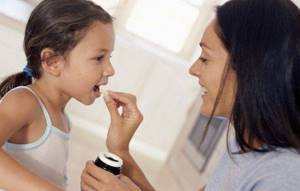
Drug groups:
- anti-inflammatory, antipyretic drugs;
- antibiotics and antivirals;
- glucocorticosteroids;
- for hemorrhagic diathesis and thrombocytopenia, vitamin C, K, and iron supplements are prescribed.
Children are treated in a hospital setting. This allows you to constantly monitor the patient’s condition, monitor dynamics, and adjust drug therapy.
Folk remedies
Alternative medicine methods can be used as aids. They will help eliminate unpleasant symptoms of diseases, inflammatory processes, and strengthen the immune system.
The best remedy for combating inflammatory processes in the organs of the genitourinary system remains rosehip infusion. Grind 2 tbsp. l. dry or fresh berries, pour 500 ml of boiling water, leave for 7 hours, strain thoroughly. Dosage – 50-70 ml. This drink eliminates unpleasant symptoms and strengthens the immune system, but it should not be drunk before bed.
A good antibacterial, antiseptic and anti-inflammatory agent is chamomile infusion. Pour 220 ml of boiling water over 10-15 g of dried inflorescences, leave in a closed container for at least 30 minutes. Take 15 ml 4-5 times a day.
Lingonberry effectively copes with diseases of the genitourinary system. Pour 200 ml of boiling water over 1 tbsp. l. crushed leaves, leave to infuse for half an hour. Give your child 70 ml of the strained drink three times a day.
Diagnosis and treatment methods for red skin
If a corresponding problem arises, parents are concerned about the question of when the redness in the newborn will go away. The answer depends entirely on the cause of this condition, which can only be found out after undergoing an examination. If the child was born red, then a visual examination is performed by the doctor for diagnosis.
Note! All elements of the rash have a characteristic appearance. As a rule, tests are not performed for these types of rashes.
Instrumental diagnostics are required if the diagnosis of hemangioma is confirmed. Since such dilated vessels can be on internal organs, an ultrasound examination of the abdominal cavity and retroperitoneal space is performed.
The basics of treating red skin in infants are considered, first of all, to prevent overheating and prevent re-irritation of the skin.
Nurse's diet
In the case of breastfeeding, it is necessary to remove from the mother’s diet all foods that can cause allergies: these are, first of all, citrus fruits, berries, chocolate, honey. It is recommended to establish a balanced diet. You should eat porridge, lean meat, vegetables, and tea with milk.
Treatment with brilliant green
If the skin color of a newborn baby becomes red and rashes appear, doctors often prescribe treating these areas with brilliant green. It is an excellent antiseptic.
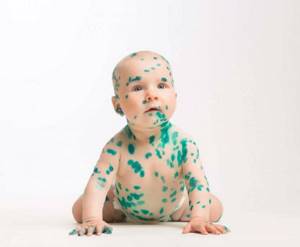
Treatment of red spots on the skin of a baby with green paint
Antiallergic drugs
Unlike adults, childhood skin diseases manifest themselves a little differently.
Therefore, it is important to be extremely careful not to miss swelling, blisters and changes in the usual allergic spots on the skin
If the baby has a red face, and the cause of this condition is an allergy, then in this case one of the following drugs is prescribed:
- D-panthenol;
- Bepanten;
- Fenistil;
- Suprastin;
- Claritin.
The drug is selected individually in each case, depending on age and diagnosis.
Special reasons
A newborn's urine changes as the baby adapts to new living conditions. From the moment complementary foods are introduced, it will also change, due to the same adaptation mechanisms. At about 1 year old, the baby no longer depends on outside influences, and deviations indicate specific health problems.
The urine of a month-old and newborn baby may also change for the following reasons:
- Fluid deficiency;
- High physical activity;
- Infections;
- A large amount of a specific product in the diet (fish, carrots, beets, pumpkin, currants)
- Pathologies causing swelling;
- Liver pathologies (they may occur as the baby grows older, or the child may be born with the disease);
- Viruses complicated by intense sweating;
- Hemoglobin breakdown;
- Kidney congestion;
- Systemic pathologies (the entire body suffers from joints to muscle tissue);
- Bladder abnormalities;
- Hypervitaminosis (any vitamin in excess can change the color of urine, even banal ascorbic acid).
